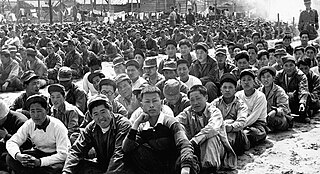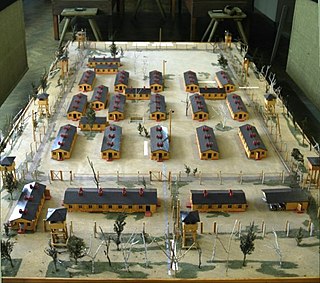
A prisoner of war (POW) is a person who is held captive by a belligerent power during or immediately after an armed conflict. The earliest recorded usage of the phrase "prisoner of war" dates back to 1610.
The Commando Order was issued by the OKW, the high command of the German Armed Forces, on 18 October 1942. This order stated that all Allied commandos captured in Europe and Africa should be summarily executed without trial, even if in proper uniforms or if they attempted to surrender. Any commando or small group of commandos or a similar unit, agents, and saboteurs not in proper uniforms who fell into the hands of the German forces by some means other than direct combat, were to be handed over immediately to the Sicherheitsdienst for immediate execution.

Operation Basalt was a small British raid conducted during World War II on Sark during the German occupation of the Channel Islands.

Bowmanville is a town of approximately 40,000 people located in the Municipality of Clarington, Durham Region, Ontario, Canada. It is approximately 75 km (47 mi) east of Toronto, and 15 km (9.3 mi) east of Oshawa along Highway 2. Bowmanville was first incorporated as a town in 1858, but later incorporated with the neighbouring townships of Clarke and Darlington in 1974 forming the Town of Newcastle, which was renamed in 1994 to the Municipality of Clarington. Bowmanville is part of the Greater Toronto Area.

A prisoner-of-war camp is a site for the containment of enemy fighters captured as prisoners of war by a belligerent power in time of war.
Marlag und Milag Nord was a Second World War German prisoner-of-war camp complex for men of the British and Canadian Merchant Navy and Royal Navy. It was located around the village of Westertimke, about 30 km (19 mi) north-east of Bremen, though in some sources the camp's location is given as Tarmstedt, a larger village about 4 km (2.5 mi) to the west. There were also American merchant seamen detained here as well as some U.S. Navy personnel.

Stalag Luft III was a Luftwaffe-run prisoner-of-war (POW) camp during the Second World War, which held captured Western Allied air force personnel.

Major Michael John O'Leary VC was an Irish soldier and police officer who was a recipient of the Victoria Cross, the most prestigious award for gallantry in the face of the enemy that can be awarded to British and Commonwealth military personnel. O'Leary achieved his award for single-handedly charging and destroying two Imperial German Army barricades defended by machine gun positions near the French village of Cuinchy, in a localised operation on the Western Front during World War I.

The Bowmanville POW camp also known as Camp 30 was a Canadian-run POW camp for German soldiers during World War II located in the community of Bowmanville, Ontario in Clarington, Ontario, Canada. In September 2013, the camp was designated a National Historic Site of Canada.
In April 1941, inmates at the Angler POW Camp near Neys Provincial Park on the north shore of Lake Superior planned the largest escape from a Canadian POW camp during World War II. The escape was the largest of its kind in Ontario, Canada.
Wolfgang Heyda was a German U-boat commander during World War II.

Operation Kiebitz was a failed German operation during World War II to organize the escape of four skilled U-boat commanders from a Canadian prisoner of war camp in Bowmanville, Ontario. The subsequent counter operation by the Royal Canadian Navy, Operation Pointe Maisonnette, became a key engagement in the Battle of the St. Lawrence and was also successful in thwarting the Germans' plan.

Skorpa prisoner of war camp was a facility built by the Norwegian 6th Division to hold German prisoners of war during the 1940 Norwegian Campaign of the Second World War. Skorpa was the main PoW camp in Northern Norway and held around 500 civilian and military prisoners when it was shut down at the end of the Norwegian Campaign.

Peter Stevens was a German Jew who flew bombers in the British Royal Air Force in World War II. As an enemy alien living in London in the late 1930s, Hein assumed the identity of a dead schoolfriend in order to join the RAF at the outbreak of hostilities.
The following events occurred in October 1942:
Whitewater was a labour camp for German prisoners-of-war in Riding Mountain National Park, Manitoba. Operating from 1943 to 1945, the camp was built on the northeast shore of Whitewater Lake, approximately 300 kilometres (190 mi) north-west of Winnipeg. The camp consisted of fifteen buildings and housed 440 to 450 prisoners of war.

Alfred Burke Thompson (1915–1985), was an officer in the Royal Air Force and then the Royal Canadian Air Force, was the first Canadian taken prisoner in World War II, was a participant in the 'Great Escape', and was the Canadian who was the longest ever held as a prisoner of war.
Ulrich Steinhilper was a World War II Luftwaffe fighter ace who made numerous attempts to escape after he was shot down and captured. As a post-war IBM typewriter salesman, he was an early proponent of word processing, considered by some to have either coined the phrase or even originated the concept.
The Veterans Guard of Canada was a citizen militia supporting the Canadian Army during the Second World War, tasked with defending mainland Canada. They were modelled after the British Home Guard.










